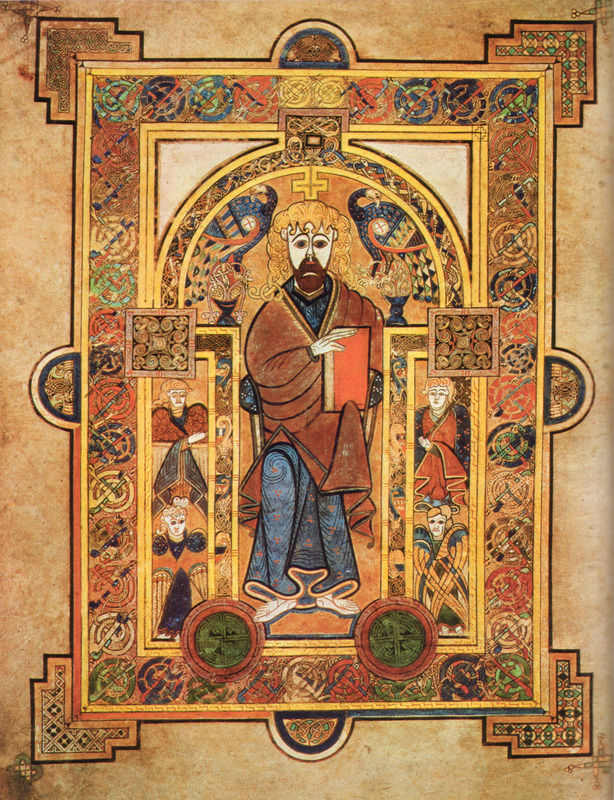Title
Cover Image - Book of Kells
Description
The Book of Kells contains the four Gospels of the Christian scriptures written in black, red, purple, and yellow ink in an insular majuscule script, preceded by prefaces, summaries, and concordances of Gospel passages. Today, it consists of 340 vellum leaves, or folios. The majority of the folios are part of larger sheets, called bifolios, which are folded in half to form two folios. The bifolios are nested inside of each other and sewn together to form gatherings called quires. On occasion, a folio is not part of a bifolio but is instead a single sheet inserted within a quire. The extant folios are gathered into 38 quires. There are between four and twelve folios (two to six bifolios) per quire; the folios are commonly, but not invariably, bound in groups of ten. Some folios are single sheets, as is frequently the case with the important decorated pages. The folios had lines drawn for the text, sometimes on both sides, after the bifolios were folded. Prick marks and guide lines can still be seen on some pages. The vellum is of high quality, although the folios have an uneven thickness, with some being close to leather while others are so thin as to be almost translucent.
The book's current dimensions are 330 by 250 mm. Originally, the folios were of no standard size, but they were cropped to the current size during a 19th-century rebinding. The text area is approximately 250 by 170 mm. Each text page has 16 to 18 lines of text. The manuscript is in remarkably good condition considering its great age, though many pages have suffered some damage to the delicate artwork due to rubbing. The book must have been the product of a major scriptorium over several years, yet was apparently never finished, the projected decoration of some of the pages appearing only in outline. It is believed that some 30 folios of the original manuscript have been lost over the centuries. Ussher counted 344 folios in 1621, but several leaves had already been lost by then. The overall estimate is based on gaps in the text and the absence of certain key illustrations.
The book's current dimensions are 330 by 250 mm. Originally, the folios were of no standard size, but they were cropped to the current size during a 19th-century rebinding. The text area is approximately 250 by 170 mm. Each text page has 16 to 18 lines of text. The manuscript is in remarkably good condition considering its great age, though many pages have suffered some damage to the delicate artwork due to rubbing. The book must have been the product of a major scriptorium over several years, yet was apparently never finished, the projected decoration of some of the pages appearing only in outline. It is believed that some 30 folios of the original manuscript have been lost over the centuries. Ussher counted 344 folios in 1621, but several leaves had already been lost by then. The overall estimate is based on gaps in the text and the absence of certain key illustrations.
Source
The Book of Kells is one of the finest and most famous of a group of manuscripts in what is known as the Insular style, produced from the late 6th through the early 9th centuries in monasteries in Ireland, Scotland and England and in continental monasteries with Hiberno-Scottish or Anglo-Saxon foundations. These manuscripts include the Cathach of St. Columba, the Ambrosiana Orosius, fragmentary Gospel in the Durham Dean and Chapter Library (all from the early 7th century), and the Book of Durrow (from the second half of the 7th century). From the early 8th century come the Durham Gospels, the Echternach Gospels, the Lindisfarne Gospels (see illustration at right), and the Lichfield Gospels. Among others, the St. Gall Gospel Book belongs to the late 8th century and the Book of Armagh (dated to 807–809) to the early 9th century. Scholars place these manuscripts together based on similarities in artistic style, script, and textual traditions. The fully developed style of the ornamentation of the Book of Kells places it late in this series, either from the late 8th or early 9th century. The Book of Kells follows many of the iconographic and stylistic traditions found in these earlier manuscripts. For example, the form of the decorated letters found in the incipit pages for the Gospels is surprisingly consistent in Insular Gospels. Compare, for example, the incipit pages of the Gospel of Matthew in the Lindisfarne Gospels and in the Book of Kells, both of which feature intricate decorative knot work patterns inside the outlines formed by the enlarged initial letters of the text.
Geolocation
Embed
Copy the code below into your web page

